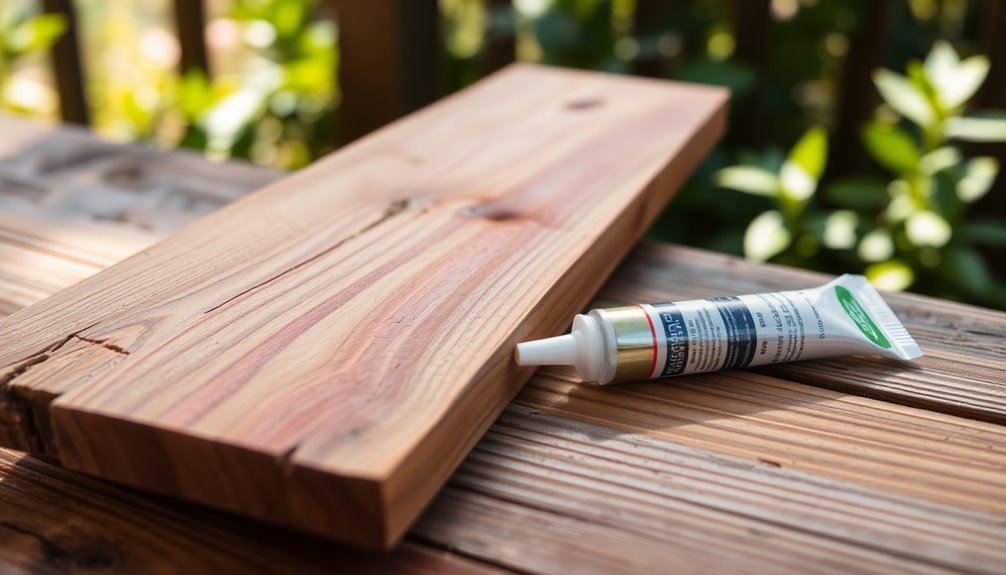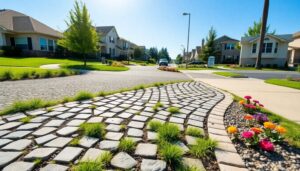When you're repairing cedar boards, the right glue makes all the difference. For affordable options, consider Titebond II or III; both provide strong, waterproof bonds and clean up easily. If you need something more robust, epoxy works well for structural repairs. Just remember to prepare your surfaces properly to guarantee maximum adhesion. Applying glue in thin layers and clamping tightly will help you achieve the best results. Keep in mind the importance of moisture resistance, especially in humid conditions. There's plenty more to discover about optimizing your repairs effectively!
Importance of Choosing the Right Glue
When it comes to working with cedar boards, choosing the right glue is fundamental for achieving strong and lasting repairs. Cedar has a high oil content and tends to swell in humid conditions, which can compromise the bond if you don't select the best wood glue. Regular reviews of your financial health can help you budget effectively for your woodworking projects. Additionally, establishing a budget can foster disciplined savings habits which will allow you to allocate funds specifically for your projects.
PVA glues, like Titebond II and III, are often the go-to choices for cedar repairs. Their excellent bonding capabilities and easy water cleanup make them suitable for various woodworking projects.
However, if you need to fill gaps or require extra strength, epoxy adhesives come highly recommended. They offer superior strength and waterproof properties, guaranteeing your repairs maintain structural integrity.
It's also essential to understand the drying and curing times of these adhesives. PVA glue requires about 24 hours for a full cure, while epoxy can set in under 10 minutes. This difference can greatly impact your repair schedule.
Additionally, choosing non-corrosive hardware is crucial to prevent staining and guarantee your repairs last. By carefully selecting your glue, you'll enhance the durability and effectiveness of your cedar board repairs. Furthermore, utilizing tools for expense tracking can help in managing the costs associated with your woodworking projects.
Types of Wood Glue Available
Choosing the right type of wood glue is essential for your cedar projects, as each adhesive offers unique properties suited to different applications.
One of the most common choices is Polyvinyl Acetate (PVA) glue. It creates flexible, permanent bonds and is water-soluble, making clean-up a breeze with just water. Expense tracking tools can help ensure you stay within budget when purchasing materials for your projects. Utilizing budgeting apps can also enhance your financial management during these projects.
If you're working on outdoor projects or areas exposed to moisture, Polyurethane glue is a great option. This moisture-activated adhesive expands while curing, providing strong and durable joints that withstand the elements.
For quick fixes, consider Cyanoacrylate (CA) glue, which dries in less than a minute, although it's not suitable for load-bearing joints.
If you're looking for a more traditional approach, hide glue is an all-natural option that can be reversed with steam—ideal for antique repairs.
For filling gaps and cracks, Epoxy is your best bet. This two-part adhesive offers waterproof and durable bonds, making it particularly effective for structural repairs in cedar boards.
Understanding these types of wood glue helps you select the right one for your specific needs, ensuring lasting results in your cedar projects. Additionally, using expense management apps can help you track and manage costs associated with your cedar projects effectively.
Testing Adhesive Strength
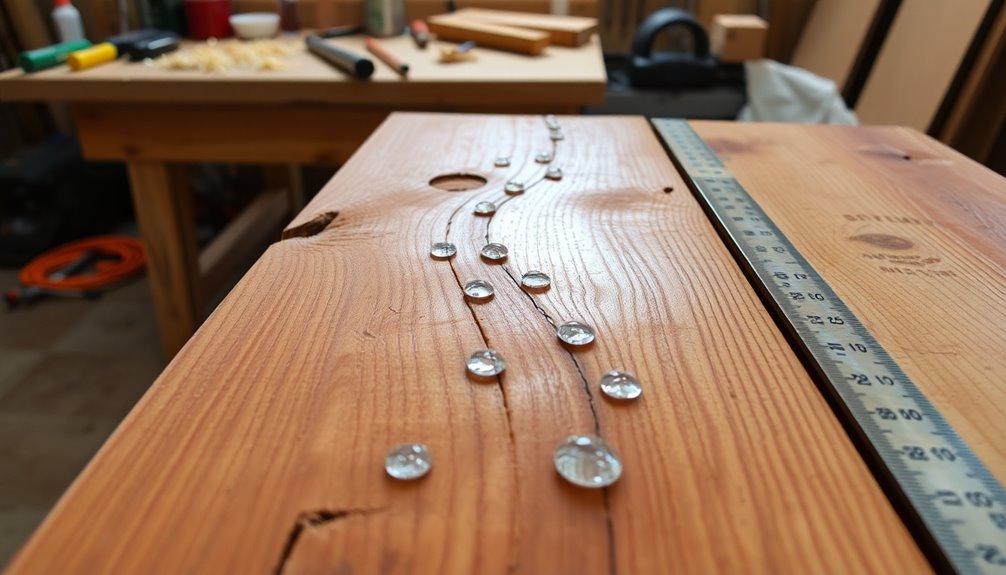
Testing adhesive strength is essential for ensuring your cedar projects hold up over time. You'll want to employ various methodologies, including end-grain to end-grain and long-grain to long-grain tests. These methods help you evaluate bond effectiveness and durability, vital for successful woodworking. Additionally, leveraging real-time insights can inform your choice of adhesives based on performance metrics.
Many wood glues, like Titebond, form bonds that can exceed the strength of cedar fibers, often causing the wood to tear instead of the adhesive failing during separation. Additionally, using the right AI-driven tools can help you optimize material choices and improve your woodworking efficiency.
To get accurate results in testing adhesive strength, consider these points:
- Perform multiple tests (3 to 5) for reliability.
- Use a scoring rubric after a 24-hour curing period.
- Compare different glue products for performance.
- Recognize that CA glue is best for temporary fixes.
- Understand that PVA glues offer stronger, long-lasting bonds.
Additionally, consistent expense categorization can aid in identifying costs associated with materials and tools for your woodworking projects.
Top Glue Recommendations
Finding the right glue for your cedar projects can make all the difference in achieving a strong and lasting bond. For most repairs, Titebond II is a top pick due to its exceptional bond strength and waterproof properties, making it perfect for both indoor and outdoor applications.
If you're looking for something that dries to a tan color, Elmer's Carpenter's Wood Glue Max is an excellent choice, providing a reliable waterproof bond that blends seamlessly with cedar.
For fine woodworking, consider Weldwood Plastic Resin Glue; it offers a strong bond and sands easily, making it ideal for detailed projects.
If your cedar boards will face harsh conditions, PL Premium adhesive stands out for its durability and temperature resistance, guaranteeing your repairs hold up over time.
Lastly, don't overlook epoxy. It's particularly beneficial in situations where you need gap filling and structural integrity. By utilizing automated payment solutions, you can ensure financial stability while investing in quality materials for your projects.
Key Considerations for Selection
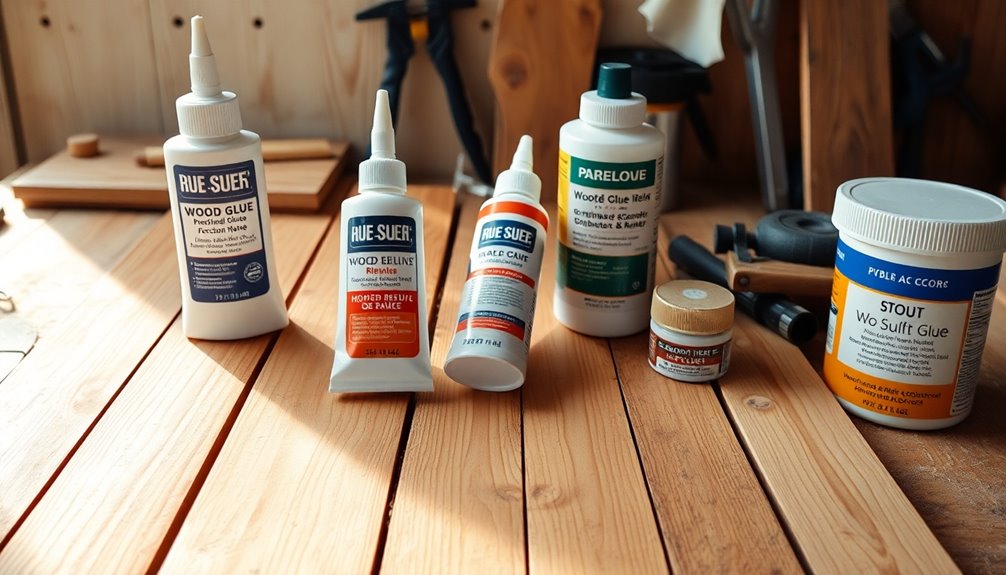
When selecting the best glue for your cedar boards, several key factors can greatly impact your project's success. Cedar's high oil content and susceptibility to moisture mean you'll want an adhesive that offers strong moisture resistance.
PVA glues, like Titebond II and III, are popular for their robust bonding capabilities and water resistance once cured. However, keep in mind their curing time; PVA glues typically take around 24 hours to fully cure, which may not suit urgent repairs.
Consider these essential factors:
- Moisture Resistance: Verify the glue can withstand humid conditions.
- Type of Adhesive: PVA glues are great for general use, while epoxy is excellent for structural repairs.
- Curing Time: Choose adhesives based on how quickly you need the bond to set.
- Future Repairs: Some glues bond poorly to themselves after curing, complicating future fixes.
- Gap-Filling Properties: Epoxy can fill gaps effectively, making it ideal for uneven surfaces.
Application Techniques for Cedar
To achieve a strong bond with cedar boards, it's vital to start with clean surfaces free of dust and debris. This prep work enhances bond strength and guarantees effective adhesion.
For your woodworking projects, using Titebond II or III is recommended since these adhesives provide waterproof bonds, making them ideal for cedar applications.
When you're ready to apply glue, do so evenly in thin layers. This approach maximizes contact between the surfaces and improves the overall bond.
If you're working on tongue and groove installations, consider using brad nailers to secure the boards temporarily. This method allows for wood movement due to temperature and humidity changes while maintaining alignment.
After applying the adhesive, clamp the boards securely to maintain consistent pressure. This step is vital for achieving a robust bond.
Don't forget to remove any excess glue promptly; this prevents finish issues and guarantees a clean appearance in your final project.
Moisture Resistance and Environmental Factors
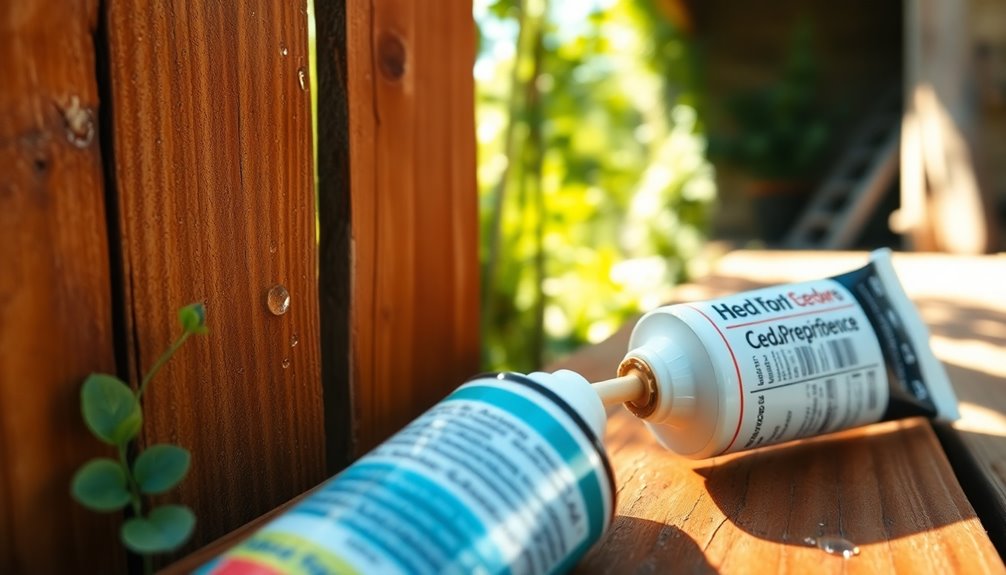
When working with cedar boards, you'll appreciate their natural moisture resistance, but humidity can still affect adhesive performance.
In high-moisture areas, it's essential to choose a glue that can handle these conditions to guarantee a strong bond.
Keep an eye on humidity levels to protect your repairs and maintain the integrity of your cedar projects.
Cedar's Natural Moisture Resistance
Cedar's natural oils act like a protective shield against moisture, making it a popular choice for outdoor projects and high-humidity areas. This moisture resistance helps cedar boards resist warping and decay, which is vital for long-lasting woodworking projects.
However, while cedar offers inherent protection, it's important to be aware of how its oils can affect glue performance, especially in humid conditions. Here are a few things to keep in mind:
- Proper ventilation is key to maintaining glued joints in cedar installations.
- Excessive moisture can signal underlying issues that need addressing.
- Monitor humidity levels to prevent swelling and cracking of cedar boards.
- Choose the right glue designed for oily woods to guarantee strong bonds.
- Regular maintenance can enhance the longevity of your cedar projects.
Understanding cedar's moisture resistance allows you to make informed decisions during your woodworking projects.
With the right approach, you can effectively use glue and maintain the integrity of your cedar boards, making sure your repairs last.
Humidity Impact on Adhesives
Humidity greatly impacts the performance of adhesives, especially in environments where cedar is commonly used. The high oil content in cedar can further complicate adhesive bonds, particularly in humid conditions. This makes it essential to choose adhesives specifically designed for oily woods.
Moisture can weaken, swell, or crack adhesives, which is especially problematic in areas like bathrooms where humidity levels fluctuate considerably.
To combat these issues, opt for high-quality adhesives like Titebond II and III, which are formulated to withstand varying humidity levels and offer enhanced moisture resistance compared to standard wood glues.
Proper ventilation in humid environments is also critical; it helps mitigate moisture concerns and reduces the risk of glue failure or wood damage over time.
Moreover, monitoring humidity levels and employing appropriate installation methods can greatly maintain the integrity of glued joints in cedar projects. By doing so, you can prevent potential expansion and contraction issues that often arise from changing environmental conditions.
Ultimately, selecting the right adhesive and taking precautions can guarantee a successful repair and longevity for your cedar boards.
Repair Challenges With Cedar Boards
Repairing cedar boards presents unique challenges due to their natural oils, which can interfere with adhesive performance. This means that when you're diving into woodworking projects, you'll need to select the strongest glue carefully to guarantee a lasting bond.
Here are some key challenges you might face:
- The high oil content can reduce bond strength, especially in humid conditions.
- Cured Titebond glues don't bond well with themselves, complicating repairs on damaged joints.
- Cedar boards may swell or crack, requiring constant moisture monitoring during your project.
- Delamination is rare, but alternative adhesives might be necessary for easier future repairs.
- Brittle adhesives can chip during shaping or fairing, impacting the durability of your repair.
You'll want to keep these factors in mind when tackling repairs on cedar boards.
Choosing an appropriate adhesive is essential for overcoming these repair challenges. By understanding the unique properties of cedar, you can enhance your woodworking experience and achieve reliable results.
Community Insights and Resources
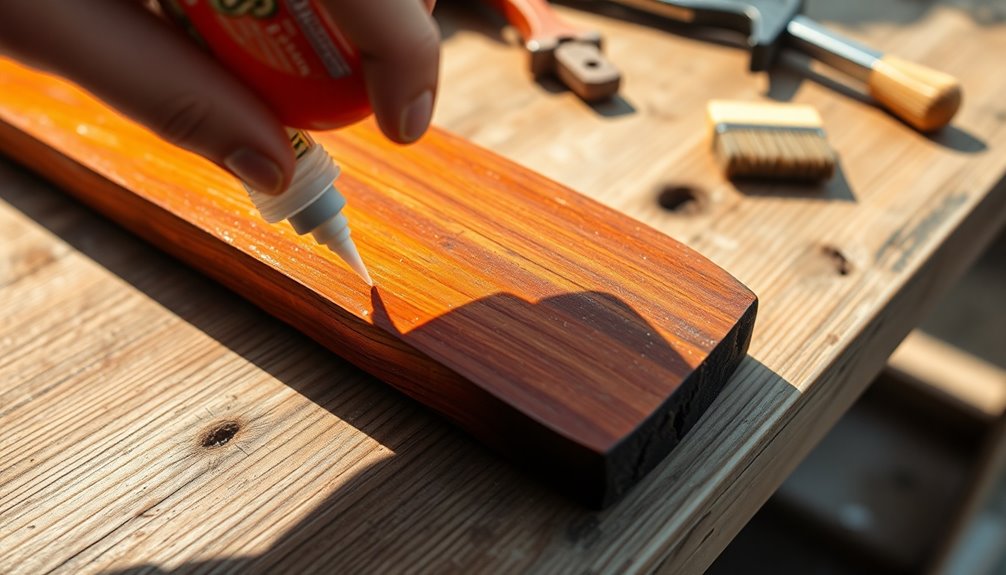
If you're looking for practical tips on repairing cedar boards, online forums like Sawmill Creek can be a goldmine of information.
You'll find discussions on the best adhesives, like Titebond II and III, along with advice on surface preparation and clamping techniques.
Engaging with the community can help you navigate any challenges you face and improve your results.
Community Tips and Tricks
Discovering the best glue for cedar boards can greatly enhance your woodworking projects, and community members have shared invaluable insights along the way.
Many users find that Titebond works fine for everyday repairs, especially with Titebond II and III being an excellent choice for their strong bonding capabilities. If you're tackling larger repairs, consider epoxy for gap filling and structural integrity.
Before diving into your project, keep these tips in mind:
- Always clean and prepare surfaces to maximize adhesion.
- Test your chosen glue on scrap cedar first to verify it bonds effectively.
- For outdoor furniture, choose a waterproof adhesive to withstand the elements.
- Don't rush the drying process; allow ample time for the glue to cure fully.
- Join local woodworking groups to share experiences and gather additional tips.
Online Resources and Forums
When you're looking to enhance your woodworking skills, online resources and forums can be invaluable. Platforms like Sawmill Creek serve as community hubs where woodworking enthusiasts share their experiences and techniques for repairing cedar boards.
You can immerse yourself in discussions that highlight the critical factors in adhesive selection, with many users recommending Titebond II and III for their strong bonding properties specifically for cedar applications.
These online communities are treasure troves of information, where users exchange tips on effective clamping techniques and surface preparation to maximize adhesive performance.
Whether you're a seasoned pro or a DIY enthusiast, active participation in these forums opens doors to insights that can elevate your projects.
Additionally, many forums provide helpful resources such as FAQs and guides that can steer you toward best practices in woodworking and adhesive selection for cedar repairs.
By engaging with these online resources, you not only expand your knowledge but also foster a collaborative learning environment that can lead to better outcomes in your woodworking endeavors.
Embrace these platforms, and you'll find yourself well-equipped to tackle your cedar board repairs with confidence.
Conclusion
In the world of cedar repairs, remember that "a stitch in time saves nine." By choosing the right glue and applying it properly, you can extend the life of your cedar boards without breaking the bank. Keep in mind moisture resistance and the unique challenges cedar presents. With the right techniques and a bit of patience, you'll have your boards looking as good as new. Happy repairing, and don't forget to enjoy the process!

